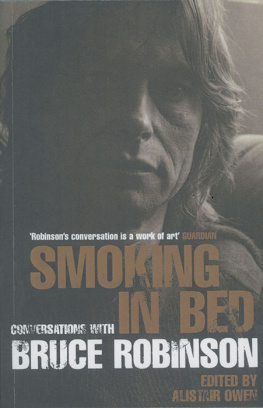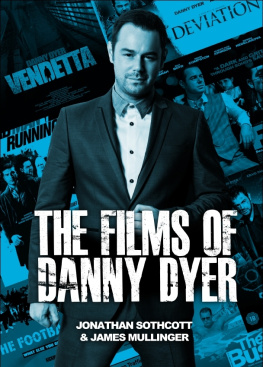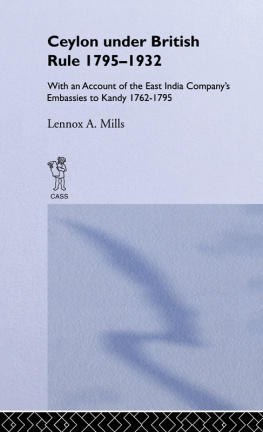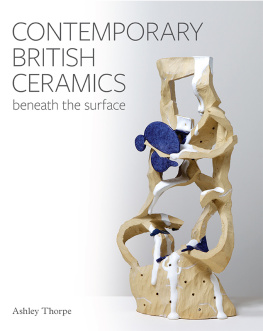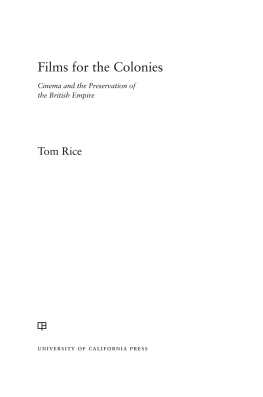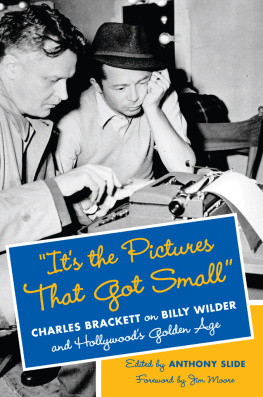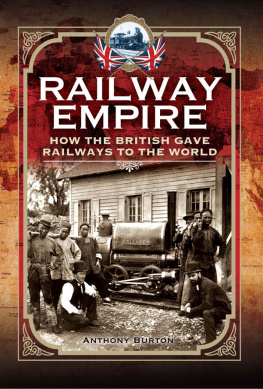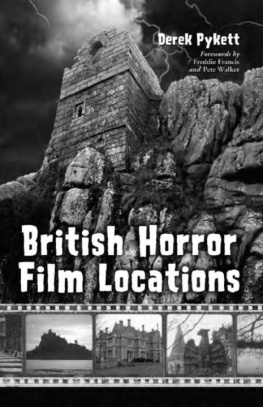Anthony Slide - Fifty Classic British Films, 1932-1982: A Pictorial Record
Here you can read online Anthony Slide - Fifty Classic British Films, 1932-1982: A Pictorial Record full text of the book (entire story) in english for free. Download pdf and epub, get meaning, cover and reviews about this ebook. year: 2013, publisher: Dover Publications, genre: Art. Description of the work, (preface) as well as reviews are available. Best literature library LitArk.com created for fans of good reading and offers a wide selection of genres:
Romance novel
Science fiction
Adventure
Detective
Science
History
Home and family
Prose
Art
Politics
Computer
Non-fiction
Religion
Business
Children
Humor
Choose a favorite category and find really read worthwhile books. Enjoy immersion in the world of imagination, feel the emotions of the characters or learn something new for yourself, make an fascinating discovery.
- Book:Fifty Classic British Films, 1932-1982: A Pictorial Record
- Author:
- Publisher:Dover Publications
- Genre:
- Year:2013
- Rating:5 / 5
- Favourites:Add to favourites
- Your mark:
- 100
- 1
- 2
- 3
- 4
- 5
Fifty Classic British Films, 1932-1982: A Pictorial Record: summary, description and annotation
We offer to read an annotation, description, summary or preface (depends on what the author of the book "Fifty Classic British Films, 1932-1982: A Pictorial Record" wrote himself). If you haven't found the necessary information about the book — write in the comments, we will try to find it.
Fifty Classic British Films, 1932-1982: A Pictorial Record — read online for free the complete book (whole text) full work
Below is the text of the book, divided by pages. System saving the place of the last page read, allows you to conveniently read the book "Fifty Classic British Films, 1932-1982: A Pictorial Record" online for free, without having to search again every time where you left off. Put a bookmark, and you can go to the page where you finished reading at any time.
Font size:
Interval:
Bookmark:
DOVER BOOKS ON CINEMA AND THE STAGE
THE HOLLYWOOD MUSICAL: A PICTURE QUIZ BOOK, Stanley Appelbaum. (23008-2) $4.50
THE NEW YORK STAGE: FAMOUS PRODUCTIONS IN PHOTOGRAPHS, Stanley Appelbaum (ed.). (23241-7) $6.00
STARS OF THE AMERICAN MUSICAL THEATER IN HISTORIC PHOTOGRAPHS, Stanley Appelbaum and James Camner (eds.). (24209-9) $9.95
THE MOVIES: A PICTURE QUIZ BOOK, Stanley Appelbaum and Hayward Cirker. (20222-4) $4.95
SILENT MOVIES: A PICTURE Quiz BOOK, Stanley Appelbaum. (23054-6) $2.50
WORLD DRAMA: AN ANTHOLOGY, Barrett H. Clark (ed.). (20057-4, 20059-0) Two-volume set $17.90
THE WESTERNS: A PICTURE QUIZ BOOK, John Cocchi. (23288-3) $3.00
NOTES OF A FILM DIRECTOR, Sergei Eisenstein. (22392-2) $7.00
STARS OF THE BROADWAY STAGE, 1940-1967, IN PERFORMANCE PHOTOGRAPHS, Fred Fehl. (24398-2) $8.95
THE TALKIES: ARTICLES AND ILLUSTRATIONS FROM A GREAT FAN MAGAZINE, Richard Griffith (ed.). (22762-6) $7.95
FILM-STAR PORTRAITS OF THE FIFTIES, John Kobal (ed.). (24008-8) $7.95
GREAT FILM STILLS OF THE GERMAN SILENT ERA, John Kobal (ed.). 24195-5) $7.95
HOLLYWOOD GLAMOR PORTRAITS, John Kobal (ed.). (23352-9) $6.95
MOVIE-STAR PORTRAITS OF THE FORTIES, John Kobal. (23546-7) $6.50
THE ASTORIA STUDIO AND ITS FABULOUS FILMS, Richard Koszarski. (24475-X) $9.95
SWEDISH FILM CLASSICS, Aleksander Kwiatkowski. (24304-4) $7.95
GREAT RADIO PERSONALITIES IN HISTORIC PHOTOGRAPHS, Anthony Slide. (24298-6) $7.95
FIFTY GREAT AMERICAN SILENT FILMS, 1912-1920: A PICTORIAL SURVEY, Anthony Slide and Edward Wagenknecht. (23985-3) $7.95
Paperbound unless otherwise indicated. Prices subject to change without notice. Available at your book dealer or write for free catalogues to Dept. Movies, Dover Publications, Inc., 31 East 2nd Street, Mineola, N.Y. 11501. Please indicate field of interest. Each year Dover publishes over 200 books on fine art, music, crafts and needlework, antiques, languages, literature, childrens books, chess, cookery, nature, anthropology, science, mathematics, and other areas.
Manufactured in the U.S.A.

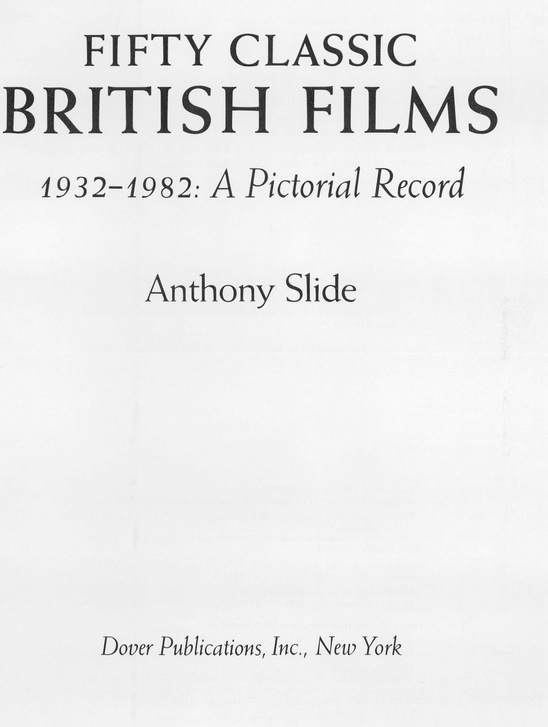
Through the years it has been my good fortune to know a number of British film personalities, many of whom, alas, are no longer with us. Therefore, this book is dedicated to Anna Neagle and Mabel Poulton, and to the fond memory of Betty Balfour, Walter Forde, George Pearson, John Stuart, and Herbert Wilcox.
COVER: Finlay Currie as Magwitch and Anthony Wager as the young Pip in Great Expectations (1947).
FRONTISPIECE: Paul Scofield as Sir Thomas More in A Man for All Seasons (1966).
Copyright 1985 by Anthony Slide.
All rights reserved under Pan American and International Copyright Conventions.
Published in Canada by General Publishing Company, Ltd., 30 Lesmill Road, Don Mills, Toronto, Ontario.
Published in the United Kingdom by Constable and Company, Ltd., 10 Orange Street, London WC2H 7EG.
Fifty Classic British Films, 1932-1982: A Pictorial Record is a new work, first published by Dover Publications, Inc., in 1985.
Manufactured in the United States of America
Dover Publications, Inc., 31 East 2nd Street, Mineola, N.Y. 11501
Library of Congress Cataloging in Publication Data
Slide, Anthony.
Fifty classic British films, 1932-1982.
Bibliography: p. 151
1. Moving-pictures-Great BritainPlots, themes, etc. 2. Moving-picturesHistoryPictorial works. I. Title. II. Title: 50 classic British films, 1932-1982. PN1993.5.G7S57 1985 791.43750941 84-21230
9780486148519
PREFACE
In a 1929 letter, Terry Ramsaye, the pioneer American film historian, wrote, May I, at this time, observe that I consider all British picture makers lousyand that the art of photography is practically unknown in Great Britain, so far as the motion picture screen is concerned. A few years later Ramsaye would have been forced to revise his estimation of the British film industry, as more and more British features found their way onto American screens, and producers such as Alexander Korda and J. Arthur Rank turned the British cinema from an insular affair into an international industry. This volume chronicles fifty glorious years of British cinema, from 1932 through 1982, by selectively discussing fifty features from that period, all of major importance by virtue of artistry, commercial success or international appeal, or else as representative of a uniquely British genre.
Excluded from the selection are, of necessity, the quota pictures (from producers like Julius Hagen at Twickenham Studios) that accounted for so much of the British output in the thirties and provided a haven for many of Britains former silent directors, such as George Pearson and Maurice Elvey, whose careers had been overshadowed by those who came later. So-called quota quickies came into existence thanks to the 1927 Cinematograph Films Act, an act to restrict blind bookings and advance bookings of cinematograph films, and to secure the renting and exhibition of a certain proportion of British films. These British films, which, by the mid-thirties, had to comprise twenty percent of all features screened in British theatres, were produced cheaply and in a matter of days for an average of one pound per foot of film. Thus a typical British B picture of the thirties would be made for a total of only six thousand pounds! They may not be great films, but the sheer skill and ingenuity of their makers warrant recognition.
The British film industry was born in 1895, when Birt Acres filmed the Derby and the Oxford-Cambridge Boat Race. The next year, on February 20, 1896, a Monsieur Trewey screened the first Lumiere film program at the Polytechnic on Londons Regent Street. By the late 1890s a number of British film pioneersR. W. Paul, Arthur Melbourne-Cooper, G. A. Smith, Cecil Hepworth, Charles Urban, and othershad emerged and were producing films shown throughout the civilized world. Just as so much of American film history dates from D. W. Griffiths production of The Adventures of Dollie in 1907, so British film history dates from Cecil Hepworths production of Rescued by Rover in 1905 (although the film, apparently, was actually directed by Lewin Fitzhamon).
George Pearson, who began his film career in 1912, was the major influence on British cinema in the teens, while the twenties were dominated by Michael Balcon, Graham Cutts, Alfred Hitchcock, Victor Saville, and Herbert Wilcox. Major British features from those two decades include Hamlet (1913), A Study in Scarlet (1914), Jane Shore (1915), My Old Dutch (1915), The Better Ole (1918), Nothing Else Matters (1920), The Glorious Adventure (1922), Squibs Wins the Calcutta Sweep (1922), Woman to Woman (1923), Comin thro the Rye (1923), Reveille (1924), The Only Way (1925), The Lodger (1926), Nell Gwyn (1926), The Dawn (1928), The Constant Nymph (1928), Piccadilly (1929), Blackmail (1929), Kitty (1929), and Atlantic (1929).
During the First World War, America took away much of the market for films abroad. And to add insult to injury, there were even AmericansLarry Trimble and Florence Turner in the teens and J. Stuart Blackton in the twentieswho came over to Britain to produce films. The occasional British feature was released in the United States, but generally most British starsfrom Chrissie White and Henry Edwards, Violet Hopson and Stewart Rome through Betty Balfour and John Stuart, Mabel Poulton and Estelle Brodywere virtually unknown outside Europe.
With the coming of sound, British cinema found an immediate market in the United States, thanks to a common language. Victor Savilles Kitty (1929) even included sound sequences (with its stars John Stuart and Estelle Brody) shot at Paramounts Astoria Studios on Long Island. Hitchcocks Blackmail (1929) found an audience in the United States, as did a number of Gaumont-British and British International Pictures releases. However, it was Rome Express in 1932 which gained immediate attention in the United States, not simply because it had an American leading lady, but because it proved that British films could be the technical equals of American features and demonstrably more innovative in effects. Following Rome Express, there was a flood of British film releases, a flood that continues through the present.
Next pageFont size:
Interval:
Bookmark:
Similar books «Fifty Classic British Films, 1932-1982: A Pictorial Record»
Look at similar books to Fifty Classic British Films, 1932-1982: A Pictorial Record. We have selected literature similar in name and meaning in the hope of providing readers with more options to find new, interesting, not yet read works.
Discussion, reviews of the book Fifty Classic British Films, 1932-1982: A Pictorial Record and just readers' own opinions. Leave your comments, write what you think about the work, its meaning or the main characters. Specify what exactly you liked and what you didn't like, and why you think so.




